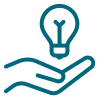|
Having trouble viewing this email? View it as a Web page.
|
|
|
|
|
Number Sense
 5 Things to Know or Do: 5 Things to Know or Do:
-
Number sense is the ability to understand numbers and the relationships between numbers. Number sense includes:
- Naming numbers in order (e.g. 1, 2, 3…)
- Recognizing numbers in print
- Understanding that each object in a group can be counted once and only once (one to one correspondence)
- Comparing quantities of objects using more/less/same
- Recognizing that the last number said when counting is the total number of objects (cardinality)
- Understanding that the number of objects is always the same even when rearranged (conservation)
- The ability to recognize “how many” are in a set without counting (subitizing)
- Provide authentic and real-life experiences whenever possible. For example, count the plates as you put them on the dinner table. Point out street numbers on houses as you go for a walk. Talk about how we use money to pay for things.
- Allow for children to play with math materials and practice what they are learning. Be creative and take a look around your house for inexpensive objects that are small enough for children to easily move. Try buttons, cotton balls, lids, Legos, dominoes, or even small rocks.
- Encourage students to talk about math and explain their thinking, even if their answer is wrong. Ask questions like “Why do you think that?” or “How do you know?”
- Provide manipulatives for problem solving. Manipulatives grab a young child’s attention and keep them engaged. When children can touch and move objects, they can think through problems and learn that there is more than one path to the answer.
 4 Children Read Alouds 4 Children Read Alouds
-
Ten Black Dots by Donald Crews (Fairfax County Library English & Spanish)
A counting book which shows what can be done with ten black dots.
-
I Know Numbers by Taro Gomi (Fairfax County Library)
How do we love numbers? Let us count the ways: They're on street signs and bus stops, featured on phones, thermometers, chalkboards, and scales. They show the time and the date, and help us to measure distance, sizing, and so much more.
-
Un Elefante by Patty Rodriguez (Fairfax County Library)
Inspired by one of the most beloved nursery rhymes in Latin America, “Un Elefante se Balanceaba,” is a traditional children's song in Spanish that has one verse repeated over and over again, while increasing the number by one each time it is sung. This book introduces little ones to counting in English and Spanish.
-
Feast for 10 by Cathryn Falwell (Fairfax County Library)
Numbers from one to ten are used to tell how members of a family shop and work together to prepare a meal.
 3 Sites to Visit 3 Sites to Visit
- NAEYC: Make Math Meaningful for Diverse Learners
-
Early Math Counts
-
Math at Your Fingertips: Songs and Fingerplays for Preschoolers
 2 Videos to View 2 Videos to View
- Number Sense by Early Math Counts
-
Let’s Talk About Math: Everyday Fun With Counting (Zero to Three)
 1 Point of Research to Access 1 Point of Research to Access
-
Early Childhood Mathematics: Promoting Good Beginnings
|
|
|
|